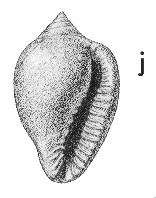
Revised descriptions of New Zealand Cenozoic Mollusca from Beu and Maxwell (1990)

 | Revised descriptions of New Zealand Cenozoic Mollusca from Beu and Maxwell (1990) | 
|
  (Pl. 20j): GS11154, J39/f26, Pareora River, foot of Mt Horrible, Otaian (GNS) |
Beu & Maxwell (1990): Chapter 11; p. 193; pl. 20 j.
Synonymy: Erato neozelanica Suter 1917, p. 12; Lachryma (Proterato) neozelanica
Type species of Proterato Schilder, 1927
Classification: Triviidae: Eratoinae
Description: Rather large for subfamily (height 12-20 mm), pear-shaped; spire low, conical, 0.15 total height, apex flattened. Whorls covered by thin callus, which almost totally obscures sutures except in abraded shells. Callus apparently absent from narrow irregular zone in middle of abapertural (dorsal) side. Protoconch planorboid, probably of about 2 whorls; teleoconch of about 4 or 5 whorls, last whorl large, weakly excavated. No sculpture, shell smooth and polished. Aperture narrow, inner and outer lips almost parallel. Base of inner lip with a strongly projecting, oblique ridge, which bifurcates at entrance to aperture, and another, less prominent one (also bifurcating in some shells) above. Posterior to these ridges is a narrow, concave gap, followed by 8-11 low denticles decreasing in strength posteriorly. Outer lip with a broad, rounded varix, leading face somewhat flattened, bearing 13-17 narrow, transverse lirae.
Comparison: Proterato neozelanica is one of the largest New Zealand eratoines and is exceeded in size only by some species of Willungia, particularly W. maoria (Pl. 24e). Apart from its size, P. neozelanica is distinguished from other eratoines by its relatively elevated, conical spire and its prominent inner lip denticles, and in having a distinct gap between these denticles and the terminal apertural ridges. P. waiauensis (Altonian-Lillburnian, Clifden) is very similar to P. neozelanica, but is somewhat more slender and has stronger denticles at the posterior end of the inner lip. P. pliocenica (Opoitian-Waipipian) reaches a similar size to P. neozelanica. It seems to differ from P. neozelanica in its last whorl being taller, narrower and more evenly tapered anteriorly, but is known by very few specimens.
Eratoines are littorinimorphans (Bouchet et al. 2005, p. 250) and are therefore only very distantly related to the superficially similar marginellids (which are neogastropods). Eratoines differ from marginellids in having a planorboid rather than a bulbous or mamillate protoconch (although this feature is usually obscured by spire callus in both groups) and in lacking columellar plaits. Although apparently extinct in New Zealand, the subfamily has a good fossil record from at least Mangaorapan to Waipipian. The records indicate that most species lived in shallow waters (inner to middle shelf) with a few extending down into the upper bathyal zone.
Distribution: Waitakian-Altonian; Target Gully Shellbed, Oamaru, Altonian (type) and other Altonian localities near Oamaru; Otekaike Limestone, Trig Z, Otiake; Campbell Park School, Otekaike; Mount Harris Formation, Bluecliffs, Otaio River; Mt Horrible, Pareora River; Coral Point, Kaipara Harbour. Uncommon or rare at all localities.
Cite this publication as: "A.G. Beu and J.I. Raine (2009). Revised
descriptions of New Zealand Cenozoic Mollusca from Beu and Maxwell (1990). GNS
Science miscellaneous series no. 27."
© GNS Science, 2009
ISBN
978-0-478-19705-1
ISSN 1177-2441
(Included with a PDF facsimile file
copy of New Zealand Geological Survey Paleontological Bulletin 58 in CD version
from: Publications Officer, GNS Science, P.O. Box 30368 Lower Hutt, New
Zealand)